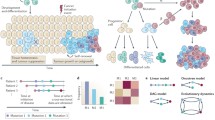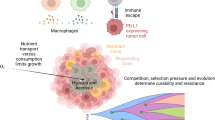Abstract
Mathematical modeling is a vehicle that allows for explanation and prediction of natural phenomena. In this chapter we present guidelines and best practices for developing and implementing mathematical models, using cancer growth, chemotherapy, and immunotherapy modeling as examples.
Access this chapter
Tax calculation will be finalised at checkout
Purchases are for personal use only
Similar content being viewed by others
References
Sanchez PJ (2006) As simple as possible, but no simpler: a gentle introduction to simulation modeling. Proceedings of the 2006 winter simulation conference, pp 2–10
de Pillis LG, Mallett D, Radunskaya AE (2006) Spatial tumor—immune modeling. Comput Math Model Med 7(2):159–176
Diefenbach A, Jensen ER, Jamieson A, Raulet DH (2001) Rae1 and H60 ligands of the NKG2D receptor stimulate tumour immunity. Nature 413:165–171
Borrelli R, Coleman C (2004) Differential equations—a modeling perspective. Wiley, New York, NY
de Pillis LG, Radunskaya AE (2001) A mathematical tumor model with immune resistance and drug therapy: an optimal control approach. J Theor Med 3:79–100
de Pillis LG, Radunskaya AE, Wiseman CL (2005) A validated mathematical model of cell-mediated immune response to tumor growth. Cancer Res 65:7950–7958
de Pillis LG, Radunskaya AE (2006) Some promising approaches to tumor—immune modeling. In: Gumel A, Castillo-Chavez C, Mickens R and Clemence DP(eds) Mathematical studies on human disease dynamics: emerging paradigms and challenges. AMS Contemporary Mathematics Series
Cooke K (1981) On the construction and evaluation of mathematical models. In: Sabloff JA (ed) Simulations in Archaeology. University of New Mexico Press, Albuquerque, NM
Author information
Authors and Affiliations
Corresponding author
Editor information
Editors and Affiliations
Rights and permissions
Copyright information
© 2012 Springer Science+Business Media, LLC
About this protocol
Cite this protocol
Pillis, L.G.d., Radunskaya, A.E. (2012). Best Practices in Mathematical Modeling. In: Reisfeld, B., Mayeno, A. (eds) Computational Toxicology. Methods in Molecular Biology, vol 929. Humana Press, Totowa, NJ. https://doi.org/10.1007/978-1-62703-050-2_4
Download citation
DOI: https://doi.org/10.1007/978-1-62703-050-2_4
Published:
Publisher Name: Humana Press, Totowa, NJ
Print ISBN: 978-1-62703-049-6
Online ISBN: 978-1-62703-050-2
eBook Packages: Springer Protocols




